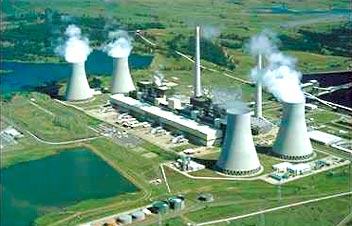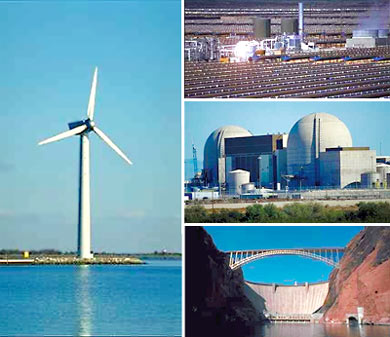One of the more interesting problems with the hydrogen economy is the hydrogen itself. Where will it come from? With the fossil fuel economy, you simply pump the fossil fuel out of the ground (see How Oil Drilling Works) and refine it (see How Oil Refining Works). Then you burn it as an energy source.
Most of us take oil, gasoline, coal and natural gas for granted, but they are actually quite miraculous. These fossil fuels represent stored solar energy from millions of years ago. Millions of years ago, plants grew using solar energy to power their growth. They died, and eventually turned into oil, coal and natural gas. When we pump oil from the ground, we tap into that huge solar energy storehouse "for free." Whenever we burn a gallon of gasoline, we release that stored solar energy.
In the hydrogen economy, there is no storehouse to tap into. We have to actually create the energy in real-time.
There are two possible sources for the hydrogen:
- Electrolysis of water - Using electricity, it is easy to split water molecules to create pure hydrogen and oxygen. One big advantage of this process is that you can do it anywhere. For example, you could have a box in your garage producing hydrogen from tap water, and you could fuel your car with that hydrogen.
- Reforming fossil fuels - Oil and natural gas contain hydrocarbons -- molecules consisting of hydrogen and carbon. Using a device called a fuel processor or a reformer, you can split the hydrogen off the carbon in a hydrocarbon relatively easily and then use the hydrogen. You discard the leftover carbon to the atmosphere as carbon dioxide.
The second option is, of course, slightly perverse. You are using fossil fuel as the source of hydrogen for the hydrogen economy. This approach reduces air pollution, but it doesn't solve either the greenhouse gas problem (because there is still carbon going into the atmosphere) or the dependence problem (you still need oil). However, it may be a good temporary step to take during the transition to the hydrogen economy. When you hear about "fuel-cell-powered vehicles" being developed by the car companies right now, almost all of them plan to get the hydrogen for the fuel cells from gasoline using a reformer. The reason is because gasoline is an easily available source of hydrogen. Until there are "hydrogen stations" on every corner like we have gas stations now, this is the easiest way to obtain hydrogen to power a vehicle's fuel cell.
The interesting thing about the first option is that it is the core of the real hydrogen economy. To have a pure hydrogen economy, the hydrogen must be derived from renewable sources rather than fossil fuels so that we stop releasing carbon into the atmosphere. Having enough electricity to separate hydrogen from water, and generating that electricity without using fossil fuels, will be the biggest change that we see in creating the hydrogen economy.

The Bayswater Power Station (New South Wales, Australia) creates electricity by using pressurized steam to run turbogenerators.
|
Where will the electricity for the electrolysis of water come from? Right now, about 68 percent (reference) of the electricity produced in the United States comes from coal or natural gas. All of that generating capacity will have to be replaced by renewable sources in the hydrogen economy. In addition, all of the fossil fuel energy now used for transportation (in cars, trucks, trains, boats, planes) will have to convert to hydrogen, and that hydrogen will be created with electricity, as well. In other words, the electrical generating capacity in the country will have to double in order to take on the demands of transportation, and then it will all have to convert from fossil fuels to renewable sources. At that point, and only at that point, will the flow of carbon into the atmosphere stop.
Right now there are several different ways to create electricity that do not use fossil fuels:

Clockwise from top-right: Solar-electric power station; nuclear power plant; hydroelectric dam; wind turbine
|
In the United States, about 20 percent of the power currently comes from nuclear and 7 percent comes from hydroelectric. Solar, wind, geothermal and other sources generate only 5 percent of the power -- hardly enough to matter.
In the future, barring some technological breakthrough, it seems likely that one of two things will happen to create the hydrogen economy: Either nuclear-power or solar-power generating capacity will increase dramatically. Remember that, in a pure hydrogen economy, the electrical generating capacity will have to approximately double because all of the energy for transportation that currently comes from oil will have to be replaced with electrically generated hydrogen. So the number of power plants will double, and all of the fossil fuel plants will be replaced.
The electrical-generation problem is probably the biggest barrier to the hydrogen economy. Once the technology is refined and becomes inexpensive, fuel-cell vehicles powered by hydrogen could replace gasoline internal combustion engines over the course of a decade or two. But changing the power plants over to nuclear and solar may not be so easy. Nuclear power has political and environmental problems, and solar power currently has cost and location problems.
 Steam pipes at the Wairakei Geothermal Generating Station.
Steam pipes at the Wairakei Geothermal Generating Station.



